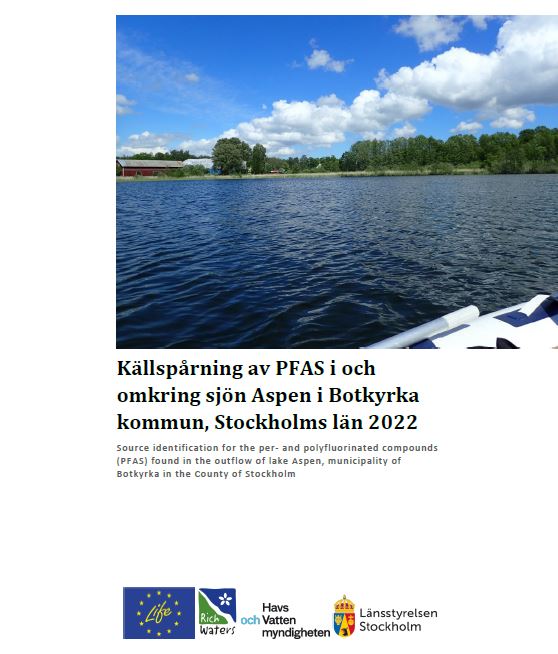The full report is available in Swedish.

Summary
In 2019 and 2021 the County administration of Stockholm performed screening studies of environmental pollutants in surface water in the whole county. During these screening studies several places revealed raised levels of per- and polyfluorinated compounds (PFAS) in the water. Some of these places were in proximity of known polluted soil sites. Others were unknown. One of these locations was found in the outflow of water from lake Aspen, in the municipality of Botkyrka. Since the outflow of this lake is directed to lake Tullingesjön and from there to lake Mälaren, both important drinking water reservoirs, the County administration decided to find the source(s) of the PFAS.
During May 2022 water samples were collected in and around lake Aspen, and analyzed for PFAS, polyaromatic hydrocarbons (PAH), metals, nutrients, chloride, and the tracer compounds caffeine and methyl-tert-butyl ether (MTBE).
Study results show that the highest concentrations of PFAS are found in the southern basin of lake Aspen, one stormwater pond south of the lake, and in the outflow from the lake, a small stream called Älvestabäcken. Lower, but prominent concentrations of PFAS were found in the northern basin of the lake. The other locations outside the lake and stream had much lower concentrations of PFAS. All the water samples had concentrations of PAH, and MTBE below the reporting limits for these compounds. Metal concentrations were generally low or very low. Measurable concentrations of caffeine in the southern basin and downstream the lake show that the lake may receive an appreciable amount of sewage water in the southern basin. Chloride variations indicate that the southern lake basin is impacted by stormwater discharge.
This report contains an analysis of the individual PFASs contribution to the total concentrations found. There are similarities among the samples collected in the same basin of the lake. The only sample that revealed all thirteen of the measurable PFAS compounds was AB 22D, the small stormwater pond north of the Tuna industrial area. The PFOS concentrations were highest in this sample, even though the total PFAS-26 concentration of this water sample was not the highest measured between the different samples. Significant amounts of 6:2 FTS, PFDA and EtFOSAA were found in this sample only. This leads to conclude that the source of PFAS in the Aspen area most likely can be found in the Tuna industrial complex.


